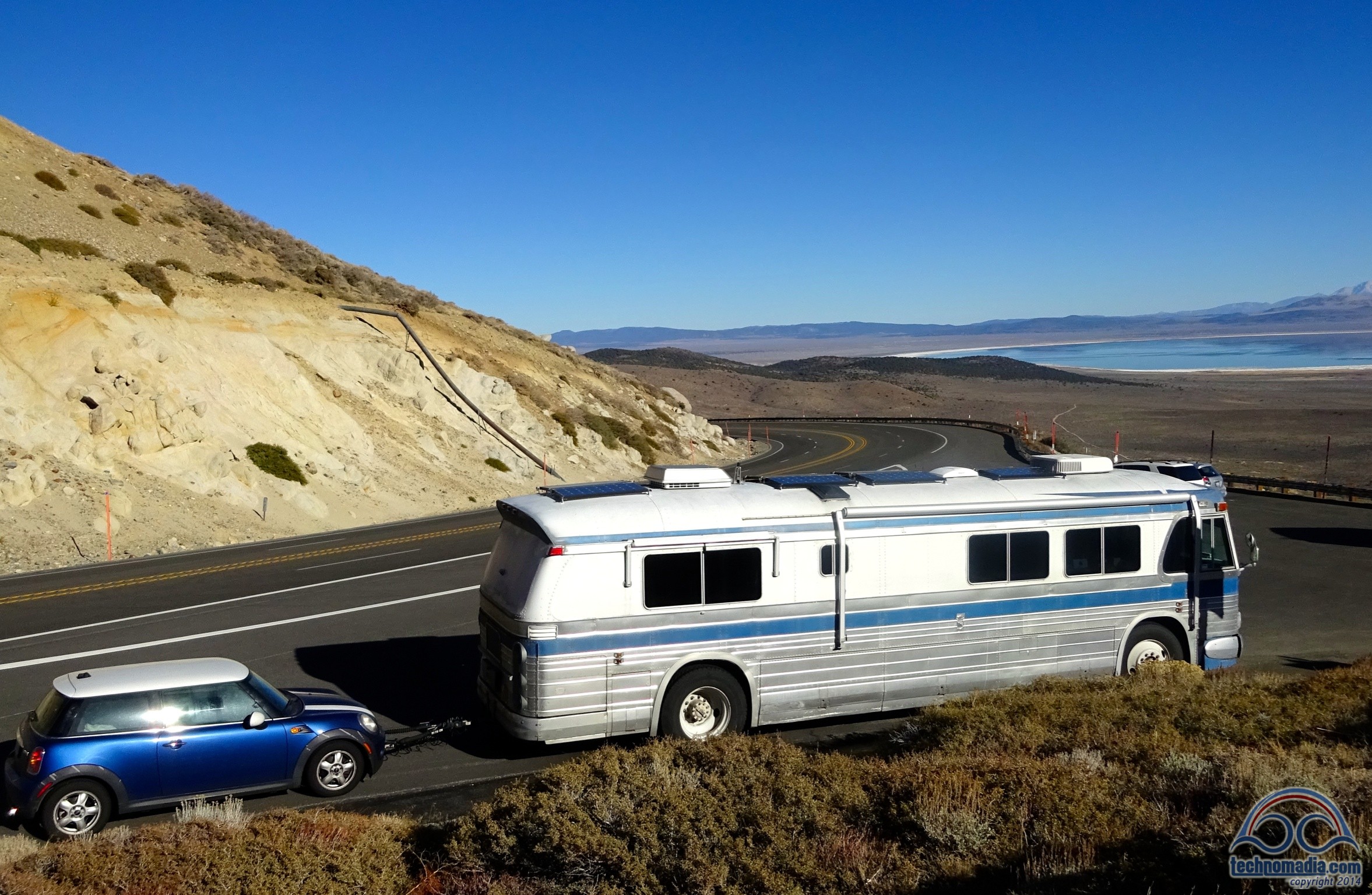
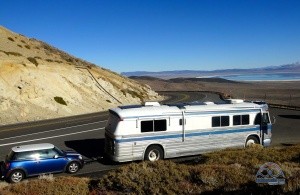
For those of you who have been paying close attention, you might have seen a little extra something perched on our roof in the last few photos we’ve shared online. Or you may have noticed that Cherie teased about leaving me behind visiting friends at AM Solar while she headed off to visit her mom in Florida.
Yes, the blatant foreshadowing is true – we at last have solar panels mounted on top of Zephyr.
800 watts of them!
And… it may be a bit of a surprise to some… we didn’t go thin and flexible!
New! We’ve added an entire Solar for RVs series to the blog with lots of articles on the topic. Included will be our on-going testing results of comparing flexible panels from GoPower, Renogy and Grape Solar.
Being Flexible About Going Flexible
When we began researching our Solar Challenge – this is what we set out to accomplish:
Our goal is to design a system for Zephyr capable of powering the bulk of our typical energy needs for several days without needing to regularly resort to a generator.
We expect that this will require somewhere between 500W to 1000W of solar, with the ultimate goal being to install as much power as we can while still looking good.
We knew from the beginning that keeping our curved-roof vintage bus looking good was going to be particularly challenging.
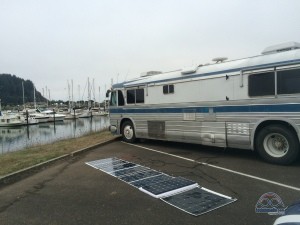
We were under the assumption that “Only thin panels that can meld with the roof lines will look good on our girl”, and we set out to find out whether any of the new crop of thin and flexible solar panels would prove worthy of the task.
We absolutely wanted to discover flexible panels that would be suitable – and we managed to get several representative samples to test.
But – the goal was never “flexible or bust”, and we even added a traditional glass panel to our testing arsenal.
We were always open to the possibility that maybe glass would win out in the end.
If only we could find a way to make it look good.
Flexible Frustrations
Even before we started – we were already aware of some yellow-flags around flexible panels.
Greg (the owner of AM Solar) had covered the roof of their personal RV with prototype flexible panels in 2013, and they had proven to have some major issues – as detailed in his original report:
The most serious problem we noticed was during a spell of 90 to 95 degree temperatures last summer. The thin covering over the cells (3mm thick) was not sufficient to keep the cells from “cupping”. This, in essence, caused each cell to form a shallow bowl which collects dust that any moisture will push to the middle of the cell. When the water evaporates, there is a small circle of dried debris that blocks enough sun to cause a power loss.
We had seen first hand how badly these relatively brand new panels were aging when we visited last year (and they are in even worse shape now), but with a new generation of thicker panels on the market for 2014 we hoped that the cupping issue in particular had been solved.
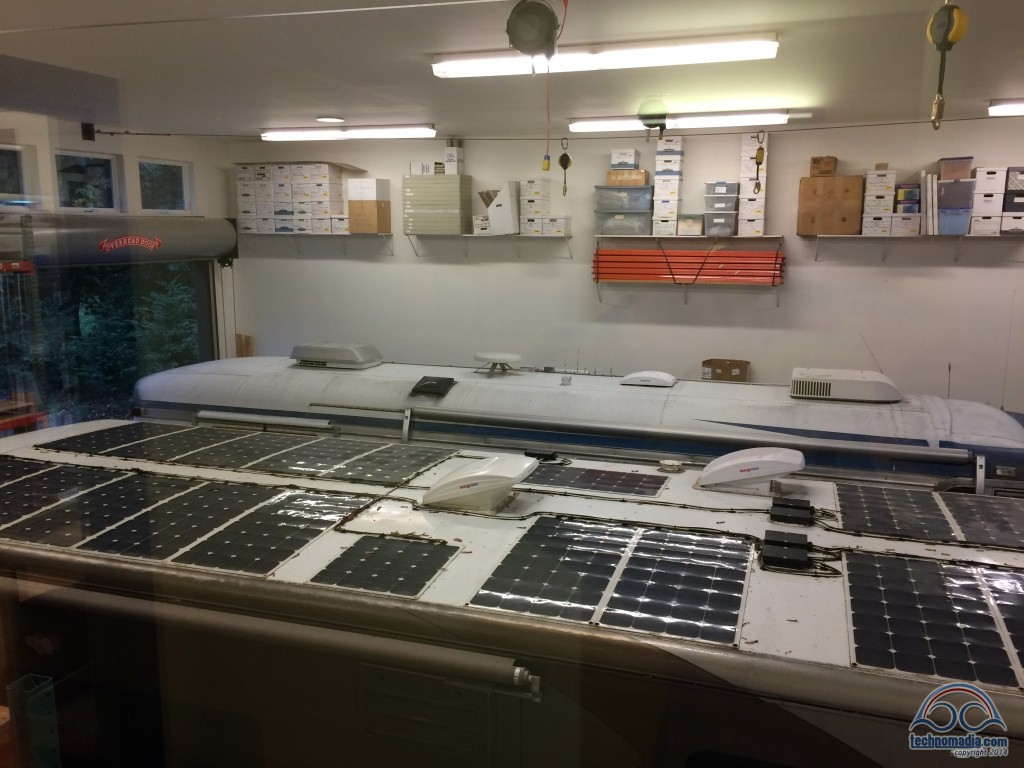
But that was only one of our concerns. As we researched more and began to test the sample flexible panels we had received, we began to become more and more aware of the potential downsides of going flexible:
- Not Walkable: Despite our dear friends Nikki and Jason Wynn dancing on their panels, we have come to learn that this is a REALLY bad idea. All the flexible panels currently available use mono-crystalline silicone cells, and even though they are encased securely inside a flexible material these crystalline cells can still develop microscopic cracks under pressure that will reduce their power output and shorten their lifetime. Therefore, walking (or dancing!) on these panels is NOT recommended – potentially making roof maintenance complicated (and dangerous) if we maximize the area covered.
- Not Tiltable: Normally tilting solar panels is more trouble than it is worth, but in the winter it can increase output substantially when the sun is low in the sky. Permanently installed flexible panels give up this flexibility.
- Scratching & Scuffing: After just a couple weeks of testing, all the flexible panels we were looking at began to show some signs of scratching and scuffing despite our careful handling. I can only imagine what scrapes against tree branches might do to a roof mounted installation! These are not just cosmetic issues – anything that keeps light from reaching the cells will lead to diminished power output. Glass by nature is just more scratch resistant.
- Longevity Concerns: Flexible panels tend to come with 10 year warranties, a third that of rigid glass panels. But having seen how badly the first generation panels aged after just a year on Greg’s roof, we had concerns on how well flexible panels will perform and how good they would look after just a few years – regardless of the warranty. Meanwhile, we have seen many rigid solar panels still looking and performing great that were installed on RV roofs a decade ago.
-
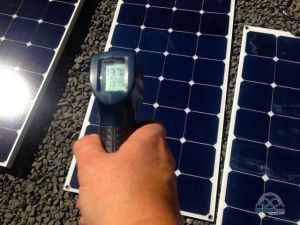
We recorded 15-20 degree differences in temperature between flexible and glass panels during peak sun tests. Heat Buildup: Solar panels, ironically, perform better when cold. But they absorb heat and get extremely hot in the sun. The framing on rigid panels have built in ventilation to help the panels stay cooler, while flexible panels get hotter and transmit all the heat buildup right into the interior of the roof they are mounted on. On a winter day (like today!) I am actually wishing for some of that heat absorption, but we were starting to have real concerns about the heat buildup potential from hundreds of watts of flexible panels on our roof in the summer. We were becoming worried that the heat build up would send us seeking power hook-ups to run the A/C sooner than we would otherwise.
- Essentially Permanent Install: The best way to install thin and flexible panels is to glue them to your roof, and after you do it is not at all an easy job to remove them down the road – especially without destroying the panels in the process. This makes it tricky to deal with defective panels, warranty swaps, upgrades to better technology, or even things like roof maintenance or painting the bus.
None of these concerns individually are insurmountable, but cumulatively there were starting to sway us away from flexible panels. We didn’t want to make a major investment into our roof that we would regret a year or three down the road.
And then…
Of the flexible panels on our radar, essentially every manufacturer had quality control issues that raised concern:
- Grape Solar: Grape Solar overall has a great reputation for their rigid panel, but they are the manufacturing partner responsible for the flexible panels that AM Solar had issues with last year. Though their new thicker 5mm PhotoFlex panel we have been testing seems to have addressed most of the issues, they still have last year to live down and their flexible panels clearly do not have a proven track record. Also – old inventory still seems to be out there too, making it tough to know in advance what you are getting unless you know what to ask for when ordering. (AM Solar sells the thicker panels now…)
We were however impressed with the performance of our test panels, and had we decided to gamble on flexible – the Grape panels probably would have been our choice. - Renogy: Though Renogy declined to send us one of their Renogy Bendable Solar Panels for comparative testing, we have had our eye on them as the cheapest flexible option we have seen – even though they are also just 3mm thick. Lynne of Winnie Views recently wrote us to share: “Renogy called me last Friday night to say they discovered that the batch of flex panels they’d been selling were lacking a waterproof coating. So, they are now in the process of sending me 3 replacement (now waterproof) panels and getting my original 3 returned.” Fortunately, she had not permanently installed the defective panels yet!
-
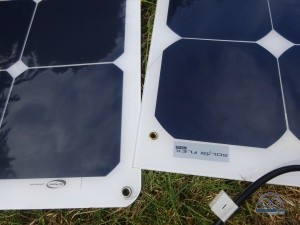
Round versus square cornered panels. If you have square from this manufacturer – beware! Panel Sample #3*: We were surprised to discover these panels substantially underperforming expectations. And one of the panels actually had a bad crimp on the connector wire, leaving it loose and unreliable. When I shared my preliminary test results with the manufacture, they replied in e-mail with: “Something is wrong with those panels. We will need to swap them out. …. It sounds like the original panels you got with the square corners were the prototype panels that were from the first run. There was not a large run of these and I don’t think there are a lot of consumers in the RV industry that would have one… The units with the round corners are all we will be producing for the RV industry moving forward.”
We delayed our testing for a long while to wait for replacement panels, which ate into a lot of our available testing time.
So far, the replacement panels have indeed been performing great. But discovering such a major issue with the first sample sure doesn’t inspire confidence for doing a full-roof install.
They are also 3mm thick, and we’ve not had enough experience with them yet to know if cupping will become an issue with them. - Panel Sample #4*: The major selling point of these panels is an integrated MPPT controller built right into the panel that is supposed to make the panels especially shade tolerant. But, in our testing, though the panel has performed well, we just haven’t seen any special benefits. And then, I just recently received this mail from the manufacturer throwing all our test data into question: “I went back on my record and I noticed that the panel I sent you had a manufacturing defect. Such module would have not be sent out to paying customer but we determine it would have been ok for your testing. If you look on the first two columns of cells there may be a short.”
- Note*: When I was an editor for a computer magazine, I occasionally busted manufacturers for sending me specially tweaked and optimized samples that performed better than what regular consumers would receive. But I’ve never run across the reverse.
We’re intentionally leaving the names of these two manufactures anonymous for now… the point of this post is the frustration of having taken so much personal time to do testing on these panels, and having late disclosures potentially invalidate our data. This is what rocked our confidence in proceeding with them.
What is it with flexible panels and manufacturing defects?!? The curse of a new technology just now coming to market, I guess.
We don’t mind being on the bleeding edge (as evidenced by over three years on lithium batteries!), but we do trust our guts. And our guts just weren’t feeling it when we contemplated making a major investment into any of these, at least not without more extensive testing in a variety of situations than we were able to accomplish while meandering around coastal Oregon.
All of these companies have good products and are worth taking a close look at, but especially with the semi-permanent nature of a flexible panel install, we just weren’t feeling ready to make that leap.
In the end, all these issues had us reconsidering our plans…
Maybe we should give up on having a large install, and settle for just a few hundred watts instead?
Or maybe we should consider waiting another year hoping for better and more proven flexible options?
Or…
Maybe glass panels are worth another look?
Opportunity Knocks & Serendipity Shines
We’ve been too swamped launching our book and the RV Mobile Internet site the past two months to write much more about solar, but we’ve continued to set up our ground deploy array of panels at various locations to test panels under a range of conditions, and we have gathered a lot of data that we are still planning to share.
But mostly, we’ve been too busy to think things through long-term to come up with a plan for what we wanted to do next. The past month was full of ridiculous amounts of mobile internet news to cover, and we didn’t have the mental bandwidth to think about solar planning much at all.
When we visited Eugene, OR last week – we really were only intending to accept the kind hospitality at AM Solar to camp for a few days, visiting with friends before dropping Cherie off for her flight to Florida.
We did not anticipate that we might have an opportunity to tackle an install – after all, AM Solar is usually booked months in advance. And, well, we didn’t think that we were ready.
But…
We knew that we were heading into a period of extended boondock caravanning with Nina & Paul of WheelingIt and a winter of meandering around the desert southwest with lots of off-grid opportunities. Having solar on the roof would be extremely useful, and we were getting a bit frustrated constantly deploying and packing up the sample solar panels at each stop.
So when we saw that AM Solar had a last-minute cancelation and the service bay was open, Cherie challenged us as she left for Florida: “Glass or flexible – figure it out, get it done!”
We had only a day to come up with a plan, but when serendipity knocks – we don’t let the opportunity pass us by!
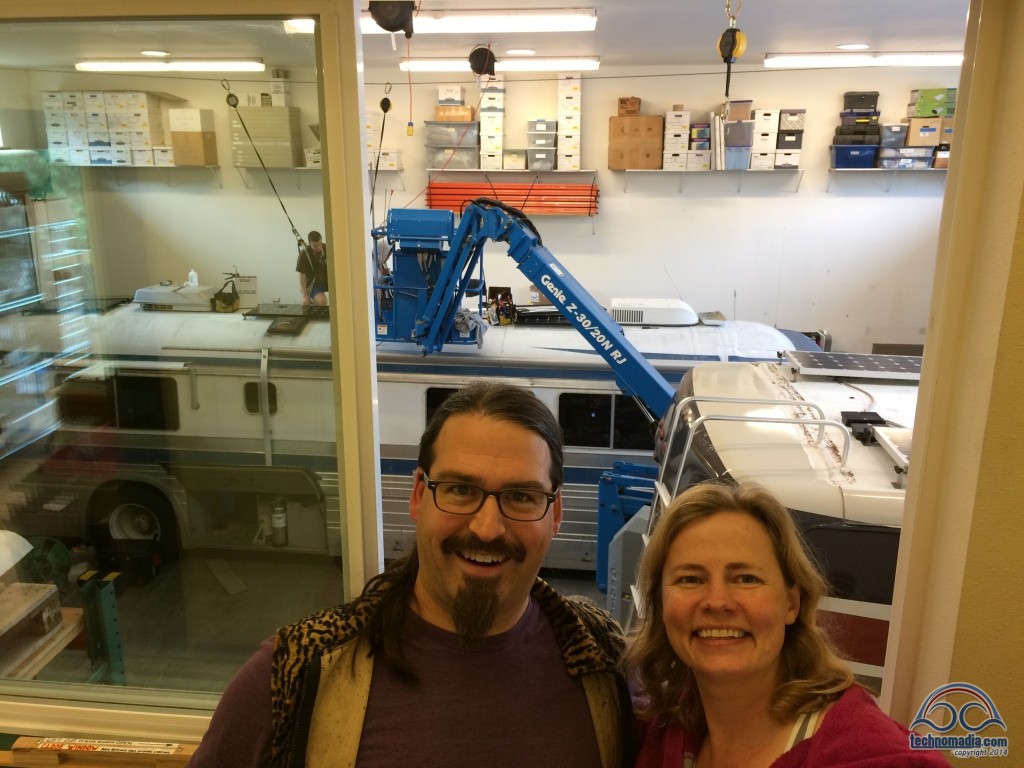
After all – if we wanted a good looking and professional install, no one does nicer work than AM Solar.
The Roof Plan
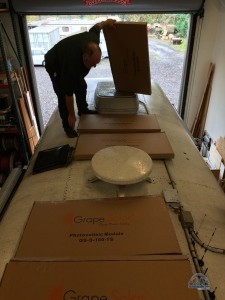
But could we come up with an installation plan that would look good on our roof?
To figure out what was possible, Greg and I engaged in the time-honored engineering practice of CAD – cardboard-aided-design. We used empty solar panel boxes, and played with several roof layouts figuring out how many panels we could fit, how they would look from the ground, and how they would mesh with the roof curves and obstructions.
We considered flexible panels, and a range of sizes of rigid glass options.
My initial paper sketches and measurements had me thinking that just 400W – 500W of glass panels would be possible, centered on the roof. More would require resorting to an asymmetric layout, awkward overhangs, and/or panel placement that just wouldn’t look good from the ground.
But once we got on the roof and started playing with cardboard, we discovered that the narrow GS100 glass panels could be placed side-by-side, tilted slightly, conforming to the curved shape of the roof. To enable this, we realized that the rigid panels could actually rise above the roof AC power conduits in a way that flat-mounted flexible panels actually could not.
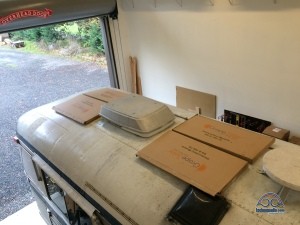
Greg came up with the idea to replace our tall sewer vent with a new low-profile 360 Siphon RV Fume Extractor that could actually fit under the glass panels, opening up the center of our roof for panels where I didn’t think any would be possible.
I even realized I could hide our WiFiRanger Sky underneath the glass panels too, further freeing up roof space.
By being able to rise above obstructions – the rigid panels ironically enabled a more flexible roof layout than would have been possible with flexible panels! But by conforming to the roof curve, we still ended up with a symmetric design that should look great from all angles.
In the end, we figured out how to fit 800 watts of panels on the roof – 8x 100W GS100 panels. Each only weighs 14.5 pounds, adding just 116 pounds to our roof – which is nothing for our sturdy bus.
And we actually worked out the mounting and wiring so that the panels could be tilted up, or folded over onto their pair to open up a walkway for future roof maintenance!
With a plan in place, Greg told his team to prepare for a long day Friday (Halloween!) tackling the installation…
The Installation
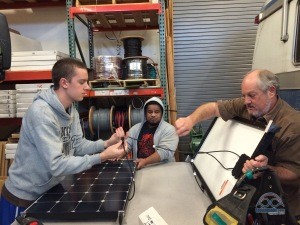
This was going to be a team effort – first I had to tackle taking down our array of WiFi and cellular gear from the roof to clear room for the AM Solar guys to work.
This also gave me the opportunity to run wires to roof mount the WiFiRanger Mobile Ti, and the new Wilson Sleek 4G.
After I cleared the way over night, the AM Solar team spent the day up on top – replacing the sewer vent, removing the old giant out-dated TV antenna, and meticulously installing and wiring up the eight panels.
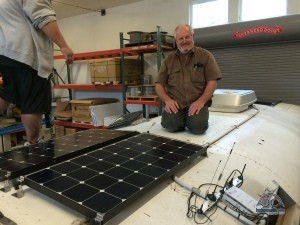
Inside the bus, it felt like a ship at sea, rocking back and forth. Kiki was particularly confused.
To provide the optimum 34V input for our MPPT solar charge controller, we decided to wire up pairs of panels in series, and then brought all the wiring together in parallel in a combiner box – also hidden under one of the panels.
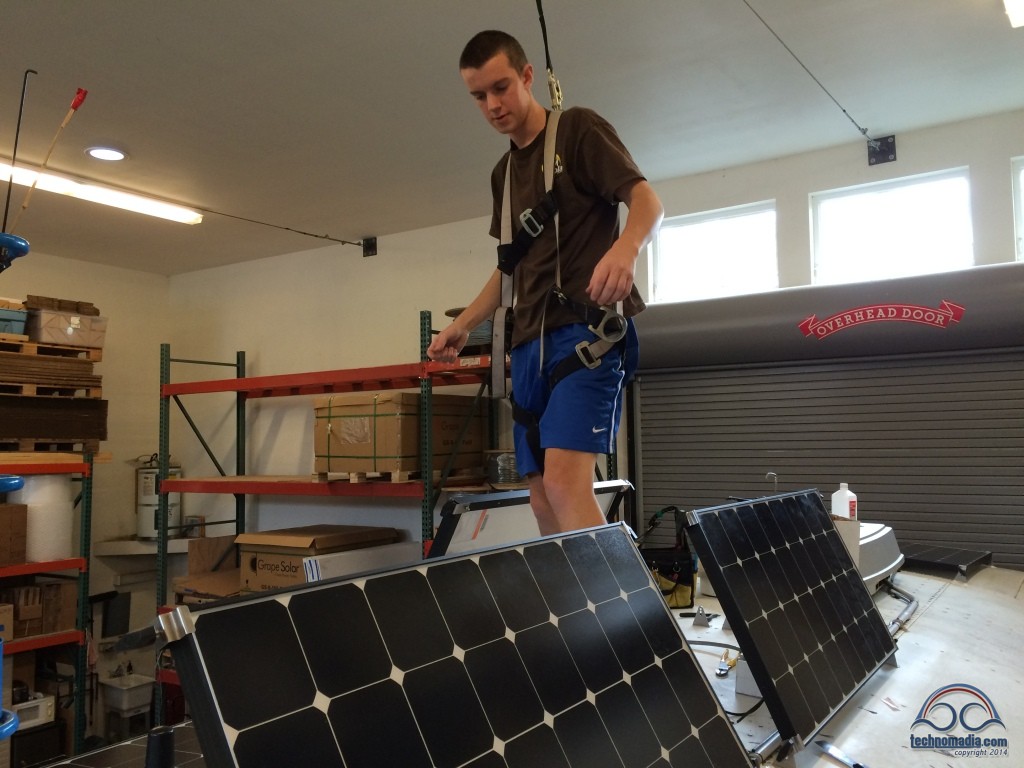
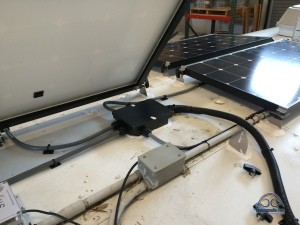
From the combiner box, we dropped a 4-gauge wire pair down through the fridge vent and into the electrical bay.
Interestingly – the 3/4″ conduit I had put in place over two years ago for a future solar install was actually too small for the thick wire, so we instead used the 1″ conduit I had been using for ethernet wires.
In hindsight – I should have installed thicker conduit the first time, but fortunately I had an easy backup option.
Down in the electrical bay, I wired the panel up to one of our Victron MPPT 100/50 charge controllers, passing first through a Midnight Solar Baby Box circuit breaker panel.
And then after the AM Solar team had gone, I returned to the roof to reinstall the cellular and WiFi gear neatly in a new location.

It was an exhausting marathon – but worth it.
The final bill was extremely reasonable too for such professional quality work – less than $4,000 for parts and labor.
Flexible Future?
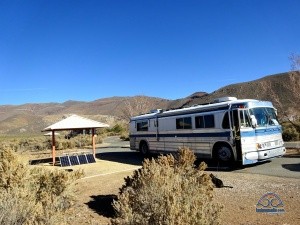
Now that we have glass on our roof, does that mean we are done with flexible panels?
Not at all.
I set up the second Victron MPPT 100/50 to be able to easily support an external ground deploy, and we think that 400W or 600W of flexible panels at the end of a long extension cord will actually prove to be the perfect compliment to our roof mounted 800W.
For ground deploy, the strengths of flexible panels shine through – they are small, light, easy to setup, easy to aim towards the sun, and easy to store. And we don’t have to worry about the heat build up in this configuration.
And best of all – they can be generating power out in full sun even if our bus is parked in the shade.
I do have a lot of comparative data to share on how the panels we have been testing have been performing – and as soon as I have the time I plan to compile it up and share it. We will also be gathering more data in a variety of climates too, now that we have left Oregon behind.
But… We couldn’t go on hiding the roof of our bus any longer – so this post on the install had to come first.
We’ll get caught up sharing more of the other details later.
Mission Accomplished?
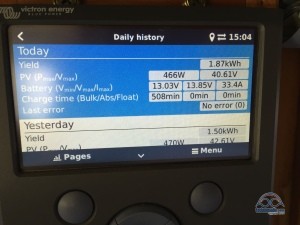
As I write this, it has been just over a week since the bus has last been plugged in to shore power.
In that time, we haven’t needed to run the generator.
But… It is winter in northern Nevada.
The sun is low in the sky, the days are short, and the mountains and trees cast long shadows.
This means that we have been needing to be always concerned with power conservation, shutting down the computers and the big inverter at night.
The literal cold reality of solar is that 800 watts of flat panels doesn’t generate an abundance of energy this time of year at these latitudes, and we have grown used to electric heat, induction and convection cooking, working all night and plugging in our electric block heater on cold mornings to start the engine.
Our all-electric coach setup will need some further refinements to thrive in these sorts of situations.
We are needing to re-learn our power-miserly ways – especially using our Mr. Heater Portable Buddy propane heater to keep the cold at bay, and putting our extra fuzzy warm sheets on the bed. Thankfully our water heater can still utilize propane, so our BBQ grill tank is supplying hot water for dishes and showers.
But during the day, we’ve been able to charge in excess of our usage and still get work done on our two huge monitors with power to spare for the evening. It has been fabulous.
We have been taking advantage of 400W of ground-deploy panels to supplement too – and being able to angle them makes a huge difference. For winter boondocking, angles really do matter. Despite the inconvenience we will need to get some tilt bars to maximize the power potential of our roof soon.
And for us – solar is about flexibility, not about never needing hookups. When the temperatures drop or work projects call for more abundant energy – there are plenty of places hookups can be found when needed, even in amazingly scenic places. It is all about finding the right balance – and at last having solar we have the flexibility to go without when we choose to.
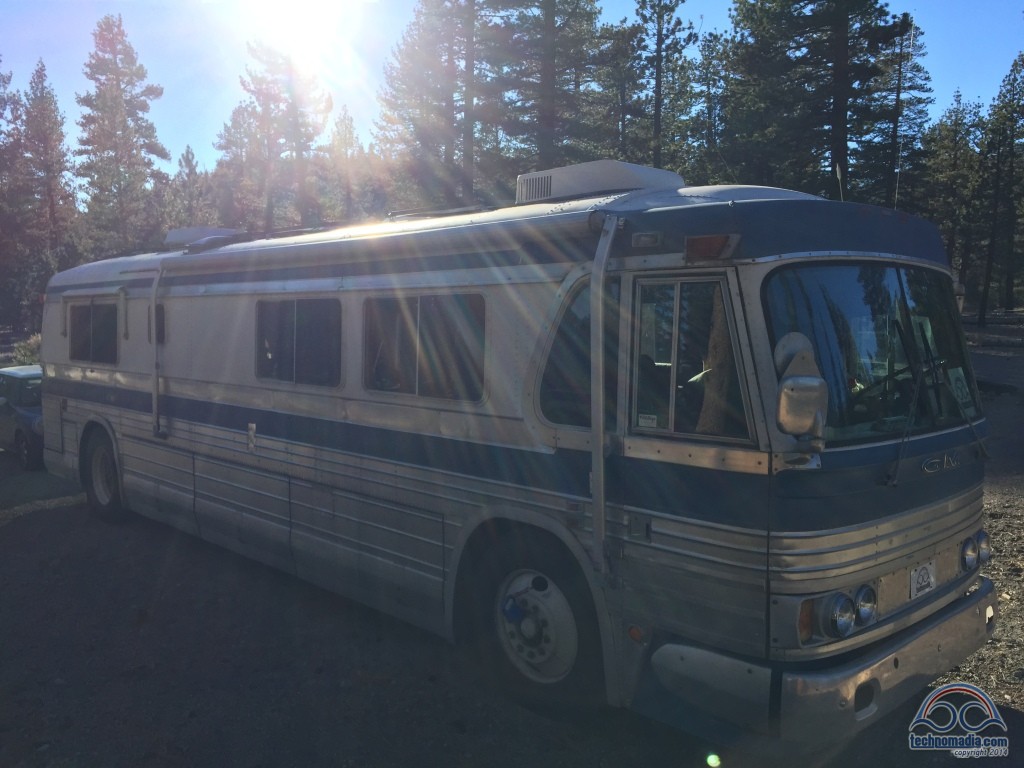
But even if we are looking forward to our next full-hookup interlude, there is more boondocking ahead in our future – and it is great to contemplate some beautiful days out in the middle of nowhere.

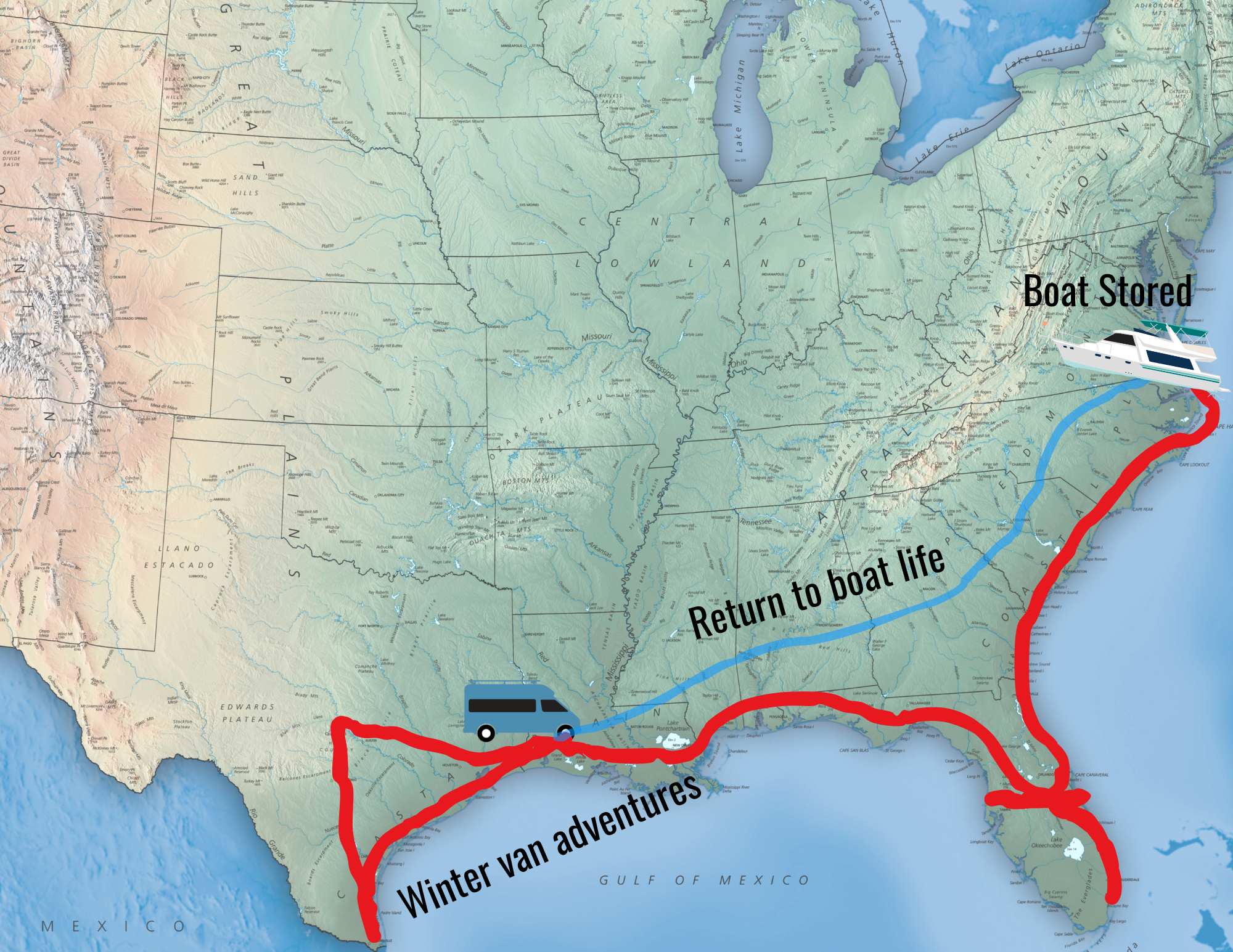
Which solar panels did you end up using for your 800 watt system?
The exact ones linked to in this article.
I’m going to be converting a 30′ 1978 Shasta 5th wheel into a vegan mobile commercial kitchen for daily operation. While I plan to use LP for cooking, I would like to power all the electrical needs by solar, with a back-up generator. My desire is to be as eco-friendly as possible. Any suggestions? I am totally new to solar. Thanks
You’ll probably want to connect in with food truck communities for advice there… aside from enjoying food trucks as consumers, afraid the electric needs are outside our scope of knowledge. Best wishes! Would be awesome to hear less generator noise around them.
Hello Chris, I guess great minds think alike etc. My wife Nancy and I cruise full time on our 45 foot Island Packet sailboat. We are currently in the Pacific Ocean near Manzanillo, Mexico I installed a Victron Multi-Plus 3K and BMV-702 monitor two years ago. Last summer we installed 800Ah or LiFePO4 packs from EPS, a Color Control GX from Victron and upgraded our solar from 375W 18V monocrystalline panels to 590W 36V monocrystalline panels with a Victron BlueSolar 150/60 controller. I was quite surprised to find your blog and see your Zephyr bus has a very similar setup. We also augment with wind power from an Eclectic Energy D400 Wind Generator and a 2KW DC diesel generator.
I am finding the solar output from the two 295W panels to be less than I expected. At 80% output I would expect to see about 470W of output, but the max I’ve seen is 360W and most of the time it seems to range between 230W and 300W. I’m also seeing the BlueSolar 150/60 history shows a significant amount of time spent in “Float” even though the BMV-702 and the EMS from Elite are showing the battery state of charge in the mid 80s percentile range. I’m wondering if the charge profile on the BlueSolar 150/60 is less than optimal for these batteries. I saw that you published the charge profile on your Multi-Plus 3K but I couldn’t find where you published the profile on your BlueSolar 100/50. Can you point me to where it is published on your blog or reply with it here?
Thanks so much,
Dan & Nancy
SV Karvi
Anchored at Ensenada Carrizal, Colima Mexico
Sounds like you have a great setup Dan!
I wonder if the wind power you have is tricking your solar controller into thinking that the batteries have reached a float point? The Victron solar controllers do not (yet) talk to the BMV to know the exact state of the batteries, but I know Victron is working on this. Until they get the firmware updated to have everything talk to each other, I just set the solar controller bulk voltage to be a bit higher.
Cheers,
– Chris
Thanks for the reply Chris. Since that posting I discovered a loose connection on an 8-1/2″ 2/0 cable on the negative side of the battery bank where the cable was bolted to a busbar. The busbar bolt was even discolored due to too much current flowing through too little surface contact. When that problem was fixed, all charging issues went away.
Enjoy your cruising time on the great loop.
Best,
Dan, SV Karvi
Is there a web page that talks more about the 1″ pipe you put on the roof of your bus?
It’s just standard PVC conduit. Nothing fancy.
Use ePVC. It’s grat in color and designed for electrical work. If running elevated support it well as it has a tendency to sag.
I have an 2001 35 foot 5th wheel. Any advice on making it solar powered? Lot’s of info and books for motor homes but not alot 4 campers.
You can find all of our solar information at: https://www.technomadia.com/solar – including our lists of reliable installers. There are many solar powered 5th wheels out there.
Hi guys, I’m just putting a new solar array on my bus roof. Do you find any issues with having opposite tilted panels that conform to your roof? i.e not all panels are flat. Does it affect performance or optimisation at all? Thanks for all your info!
For sure it has some impact. That’s why we kept ours as close together as we could to minimize it. In some cases, the performance is better (built in tilt effect) and in others it’s a negative (opposite tilt). But all and all, the setup is working for us.
Can you share specific costs of the setup? each individual item and hours of labor, labor rates?
You can find AMSolar’s current pricing on their website. Anything we paid over 2 years ago would be obsolete at this point.
Chris, getting ready to install my solar system next week. Just curious, now that you’ve had your system installed for a while, what do you think the ideal gap is between the bottom of the panel and the roof. Consider issues like shadowing, heat buildup, and wind forces, is there a “prefect” compromise in panel height? I’m making my own mounts out of aluminum angle and am trying to decide on the height.
Thanks
Jim
I don’t think there is any particular ideal. I’d vote for high enough for a bit of ventilation, and low enough to look good.
– Chris
are you running a DC/low voltage fridge? I went with one for longevity. http://www.c4pinc.com/blog/solar-rv-refrigerator/ about sums it up, but I do feel better about not having all that propane around too.
We indeed have a 12V / 24V DC-powered fridge – we went with a Vitrifrigo.
Propane is not a bad choice for RV refrigeration though. An RV fridge can go for months on a single tank of propane – it is an incredibly efficient process.
– Chris
Appreciate all your good work and Info..Thx…G Benedetto
In the past marine or gas powered refers were a Boondocker’s only efficient option. However that has changed with inverter powered house refers. Just installed a Samsung RF18 and I’ll never go back to melted ice cream again! Due mainly to its larger size and full up ice maker, I admit it’s still not as efficient as the much smaller marine refers. However with an extra panel up top it’s manageable and the convenience cannot be beat. Stylish stainless steel French doors, 2x the size for 1/2 the initial cost and still boondockable is a good trade off in my book. PLus, the old unused roof vent opening makes a great conduit for solar/electronics cables
Hey guys. Thanks for the site it has been very useful. This is going to sound like a dumb question but I really haven’t seen a good answer anywhere. How do you run the wires from the panels and other electronics on your roof into the bus? I am converting a school bus but I don’t have a real good idea on how to get the solar wires into the bus without cutting a hole. There aren’t any preexisting vents on the roof. Im fine with cutting a hole but want to understand the best way to waterproofing it after. Any thoughts would be helpful. Thanks
We were able to run conduit through an existing fridge vent to route our wiring. But if you don’t have any vents, then cutting holes in the roof is your likelihood. Study up on waterproofing (Dicor is your friend) to make the best possible installation you can – it would the same for any other wires you’d need to run. We recently hosted a video chat with The RV Geeks about running antennas to a roof, and it would be similar. Check the Video Archives for that (www.technomadia.com/video).
A word of caution. I see many people resort to using the fridge vent as a convenient way to avoid creating another hole in the roof. You do realize how hot that gets in there with the exhaust gasses of your propane burner, right? Not an ideal environment for wiring of any kind. So, it can be done but do your homework and shield it accordingly. Me? I found an extra CB antenna hole up front where I needed to come down so removed the unused antenna and used conduit. Had I not had that hole I would have simply cut one where needed.
That’s a valid point IF you have a propane fridge. We switched ours to a 12v/110 marine electrical fridge that doesn’t need nearly the ventilation that the propane one did.
We switched ours to a 12v/110 marine electrical fridge that doesn’t need nearly the ventilation that the propane one did.
Another good point Cherie. I personally have switched to 110v 10cu/ft home unit with a 2,000 watt pure sine wave inverter and a 660ah isolated house battery setup with 900w solar. I’m finding the unit very acceptable as it only draws about 10a on the DC side with their 1a 110v compressors. At a 50% duty cycle you’re only looking at a 5ah draw which isn’t too hard to maintain. It’s a hard deal to turn down at only $3-400 a unit. Curious the power consumption of your marine unit?
After contacting 12Volt Technology Support they sent this; “As for the power consumption it is rated at a maximum of 100W.
So therefore based on the usage (when you are asleep and not opening the fridge and ambient temperature is cooler it will use much less).
However mid-day during maximum ambient heat and people going into the fridge regularly it will use a maximum of 100W.”
They also send dimensions of the unit itself but still did not get an answer on the clearances or venting required to install the DP2600 Vitritrigo unit. I did see the “reduced” price is $2600 so do your homework well and make sure this unit works well for your needs.
We’ve been using it for many years.. very happy with it.
Hi Guys! Thank you so much for chronicle-ing your adventures. Especially the hard-tech stuff! I have a question: with the myriad of solar & off-grid equipment available, what led you to use Victron “stuff” for your inverter and solar charge controller needs? Thank you in advance!!
Hi Luke.. you can find all our projects notes on the original battery/inverter install on our lithium page: https://www.technomadia.com/lithium, and we also re-cover that on the generic solar page at https://www.technomadia.com/solar
I really enjoy reading your blog. And I could’ve missed the info, but I’m just wondering which flexible solar panels you’ve decided on.
Hi Val.. as explained in this article, we decided NOT to go flexible for the installation.
Hi Chris, I’m in an 1989 Winnebago Itasca. We have one 160 watt panel and a 2000w inverter. We are way off grid and the beautiful beast has probably docked permanently so how many more panels can I add to this system and how do I redirect my refrigerator to be powered from them. I am aiming for fossil fuel retirement here. Great article by the way.
If your refrigerator is propane powered and you want to go 100% solar – the first step you take should be switching to a marine/DC fridge.
Propane powered fridges are incredibly efficient when run on propane, but horribly inefficient on electric. You do not want to be running a propane gas-absorption fridge with solar as the primary power source.
Once you have an appropriate fridge, you will have to size out your system according to your locations and daily expected generation and load. It will take 400W or more to keep up with the fridge, perhaps less if you are willing to supplement with other power sources on cloudy days.
Good luck!
– Chris
Hi. Guy’s
seems to me, all of us do a same mistakes, we all think about little investment as possible, save enough money for a lots of panel and lithium battery s.,it’s will be a big smile end of the day )finally I reach a point when I do have enough (sort of ) power, …..660watts solarpanel,4 trojan 6 V battery’s, 40amp charge controller, 2000watts inverterer,…..now I realize I want a lithium battery’s,))
looks like we don’t know enough about connecting panels in serious (including me)
Why not doing that?less power loss, less wire size, what’s wrong with us? I would like to read everything about series,parallel connection
thanx guys )
zoltan, investigate propane space heaters. Much more efficient with propane and uses NO power. We love our Olympian Wave 6 (but would probably get a Wave 8 next time).
Yup.. indeed, there are other options for heat. We love our Mr. Buddy portable for the few nights we run into chilly weather. Generally we route away from temperature extremes
Hi guys
I’m living in a class A rig, with 500w solar panel, and 4 golf cart battery, even in Oregon winter, this system would be enough, if that furnace wouldn’t take so much power, until they not able to figure out better technology, much cheaper, running a honda generator all night long for $3, then spend a lot of money for solar system, it’s kind of sad, to have all those power summertime, and not enough wintertime, just because that stupid 8-10 amp furnace
Thnx
It’s more than just the power draw.. keep in mind, winter means less daylight hours and the sun is at a lower angle. This all greatly impacts the amount of energy you can collect in the winter. We designed our system around winter storage collection & usage, not summer.
I do love reading about your lithium set up,
perfect article, thanx) if you have more information about lithium battery s ,please post it,where is the best place to buy it,(quality and price)
thanx
We have an entire series on the lithium at https://www.technomadia.com/lithium – check the 3.5 year review for a list of current vendors.
Zoltan, I ran 900w panels with 4 golf cart batteries and quickly discovered I needed to go to 6 batteries. Due to the shorter winter days, non tilting panels, and heaters, home fridge with inverter, and CPAP machine I had to increase my capacity. The reality is instead of running the genset up to 10pm (quiet time) then back on at 7am that only drew 9 hours from the batteries.
But now the sun sets at 6pm and is not productive until 8:30am so the batteries are now having to support the bus for over 14 hours a day! :-0 So big difference between battery drain time from generator to solar use. To get around this I added another pair of 6v deep cycle batteries.
BTW, by 11am my batteries are already fully charged. So now researching windmill type power management so I can divert all that unused power (120v DC) to my water heating element.
I would run the generator before quiet time, you conne5 that 900watts series or parallel?
I run them in series. If shading occurs the bypass diodes kick in AND the MPPT controller makes adjustments. It’s not a simple DC series circuit like lots of people believe.
Just curious, now that you’ve had the solar up and running for a while, what’s the largest amount of amp hours you’ve managed to get into he batteries in one day?
Just this past Sunday we harvested 6.95kWh – which works out to over 530 amp hours. We had enough excess electricity to not only fully charge the batteries, but to run the water heater off of electric too.
– Chris
Wow Chris, I don’t have solar yet, but from what I’ve read 6.95kWh is impressive for 1400w in panels. Were the roof panels tilted too? I’m wondering what to expect from 1250w that will be mounted flat. I was guessing that under good conditions, 3.7kWh-4kWh. Interesting about your water heater. I’ve been debating weather I should include this as a goal for solar. Interesting article to read if you have an Atwood (I happen to have the same 10g Atwood as this guy).
http://www.rv.net/forum/index.cfm/fuseaction/thread/tid/24033351/print/true.cfm
When I measured 6.9kWh the ground panels were tilted, and half the roof panels were tilted. (We can only tilt half at a time…)
That is a great link on water heater power consumption – thanks for sharing it!
The one downside of relying on solar for water heating is the prospect of a cloudy day meaning no hot shower. We are glad we have propane as a backup for the water heater still – and someday hope to have a diesel hydronic heater.
– Chris
Thanks, both of you, for all your write-ups on your various areas of expertise! I’m struggling to “grasp” all that can be involved w/full-time RV-ing – AND getting my wife to want to learn as well! (She’s a bit “panicked” about selling our place & committing to it! I can’t blame her!) {: \
Anyway, thanks again! Great info!
Excellent write up Chris. I was in the same boat you were about a year ago. After MUCH research I found the flex not the way to go for several of the reason you mentioned. I also found with the introduction of the MPPT controllers “RV” panels were not the way to go.
Home panels are much better, reduces wire sizing, power loss, less connections, and all at 1$/watt or less. I installed 3x 300 watt panels in series for 900 watts of power at 120 Vdc. High voltage, low line loss, small wires, and the use of a Midnight Controller proved to be fantastic.
When I did my research Midnight Solar was the only controller that would handle that kind of power all in one unit (Classic 150). If you do your research you will find the frames of the solar panels vary greatly. This is where you do your research and get a good, strong framed panel. Kyrocera is a good example of a well built frame.
My install is only months old but have not used the generator nor plug in power yet. My goal is to only need the generator to run the AC units. Bottom line is the system is performing great and the entire install (parts only) was less than $1800. That includes wire, conduit, controller, panels, circuit breakers, and uni-strut.
I mounted my panels high over the AC units and all permanently flat. I figured I needed about 600 watts so over-designed so I don’t need to worry about which way I’m parked, which way the bus is facing, climbing on the roof to tilt panels every time I stop, or worrying if I put the panels down before I drove off.
The increase in vehicle height is only a couple inches and now my AC units are shaded. I can still access both my roof pods without issue since I didn’t have to purchase many smaller panels. Like you, “CAD” can determine a lot and will open up your mind as to what you can put up on that roof.
Michael Putz
Mesa, Az
Hi MPutz,
I’m about to begin my PV and would love to see your hardware since you’ve design aspects I’ve not seen. I plan to drive through AZ this month or early next. Would you mind showing off your work? My addy is at gmail and my prefix is neilrayc.
Sure.. No problem. Will be in Quartzsite the next two weekends with over 100 other Wanderlodge owners. I’m doing a show-n-tell there to my group as well. My motivation was last year hitting every Solar place at the Q and was not impressed with their responses. Having an Electro-Mech background with a degree in electronics made my questions a little “sensitive” I guess? Some even suggested I do my project then come back and show them how it was done. Their $4+ per watt systems is what motivated me to do the research. I think instead I should open up a shop there and give them a run for their money! hee hee hee
Hey Chris , this is mark from harrisville/alpena. Linda and I are in Yuma,Arizona. You and Cherie have such good information on your blog. We are looking into putting solar panels on our motor home. Hope to see you two again sometime.
Great to hear from you Mark – maybe next time we cross paths we will both be solar powered!
Chris & Cherie…
Thank You Thank You Thank You, When both banks of solar are deployed, which solar charge converter is in control of managing the battery bank? Seems like one would be trying to bulk charge and the other trying to float charge. Is there a method of selecting which is in actual control?
At the moment the solar charge controllers work independently, but since they are programmed with the same settings they tend to stay in sync. Victron has enabled a feature for their 70A charge controller that allows multiple controllers to sync up with each other (and with the inverter’s charger too), and they have said that this is coming to the 50A controllers too.
It isn’t a big issue – but it would be nice to have all our charging sources fully coordinated.
– Chris
Thanks for a great article. You give me some concern though as I have purchased two Renogy 100 watt flexible panels for my new Oliver 23.6 (delivery is next week) My plan is to use Industrial grade Velcro to attach the panels, which will allow me to remove them for cleaning, etc. I thought about a portable system, but just the hassle of setting up each time discouraged me from that.
I will self install the panels and charge controller, but Oliver pre wired for Solar with a 6/2 wire from the roof into the battery compartment. I did buy the four Trojan six volt batteries, which should provide ample storage for the Solar energy I can capture.
Thabks again for your excellent work.
David
Congrats on the new Oliver – it is such a thrill that they are back in production.
It sounds like you are putting together a nice system – are you going to be molding the panels to match the Oliver’s roof curves?
I’d love to see what the panels look like once you get them mounted.
Cheers!
– Chris
Thanks so much for your great article. I’m in the beginning stage of becoming an RVer but have been interested in solar from the beginning. I’m looking forward to learning more so that I can make the right decision. Thanks again!
Hey Chris and Cherie!
Glad that you finally joined the solar world! Great choice in panels and installers! :-))
If you’re planning to keep heading to colder climates, you might consider installing an Aqua-Hot hydronic heating/hot water system. Diesel or 120VAC (when available). I’ve done several conversions for folks and they were immensely pleased.
Drop me a note if you’re interetsed in the gory details.
Well.. re-joined the solar world We do have plans to eventually do a diesel hydronic conversion. It’s on the list.
We do have plans to eventually do a diesel hydronic conversion. It’s on the list.
I went with the D5 Hydronic Espar from Rixen’s in Sandy, OR. He is extremely knowledgeable, experienced and is meticulous with customer service.
Chris & Cherie – Congrats on the awesome solar install. What a perfect complement to your lithium pack! Realize AMSolar doesn’t list big panels but am wondering if you looked at larger glass panels to bring your $/watt cost down? I enjoyed the 2 – 210 watt panels & Blue Sky 3024iL on my Southwind for >5 years. Now that I’m ready for solar on my “new” DP, I am looking at 3 or 4 – 300 watt +/- Canadian Solar panels with a much lower $1/watt price tag! The big unknown is can I fit them onto the available real estate up top? At 38″ x 76″ the panels are huge! But if they can fit, we’d be talking less than half what your system cost (self-installed) including the Mid Nite Classic controller and a 3 or 4 panel array with 900-1200 watts!!. If 4 will fit in a 2 by side-by-side layout I’ll do it. CAD (cardboard ) is the key. Nice idea with those 360 Siphon vents and they might just make this possible! Instead of screws to mount them AMSolar should’ve used RIv Nuts. They’re much stronger and secure through thin sheet metal. Looking forward to your details write-up!
) is the key. Nice idea with those 360 Siphon vents and they might just make this possible! Instead of screws to mount them AMSolar should’ve used RIv Nuts. They’re much stronger and secure through thin sheet metal. Looking forward to your details write-up!
Hi Van –
Large residential panels are great for the $$/Watt, but they aren’t as easy to lay out, tend not to be as efficient per square foot, and we’ve been told they are not nearly as rugged for the sort of bouncing around that an RV roof goes through. But if you have the space for them and are willing to experiment – go for it. I’ve seen residential panels under $1/Watt!
As for screws vs rivnuts… Our roof isn’t thin sheet metal, it is actually rather thick aluminum. I trust that after thousands of installs, the AM Solar guys picked an optimal way to manage the attachment. They’ve seen and tried it all.
Cheers!
– Chris
As Chris stated there are differences in the home vs RV panels. I went with the larger 300w home panels for $1/w BUT, I did my homework too. IF you look at the Canadian 250w vs 300w panels you’ll see the frame is the same, flimsy. Take a look at a Kyocera and notice how much thicker and stronger the frame is. So check the dimensions of the frame on those larger panels, flex kills…
Looks like you ended up with the best of both worlds (bendable and traditional)! Glad Zephyr will now be ready to boondock in the desert! I finally got my post done about my bendable rooftop solar install: http://winnieviews.blogspot.com/2014/11/my-skinnie-solar-system.html
I was pleasantly surprised a couple weeks ago that my Renogy 300-watt bendable system was pumping out the same exact amps as a new 300-watt GS100 AMSolar system next door to me! Who knows if that will still hold true 5 years from now, but so far, the bendables are off to a great start!
Great to see your setup, Lynne! And now that you’ve revealed yourself, I’ve updated the quote about the Renogy recall to link to your write-up. Glad they’re performing so well. We’re probably going to spring for 2 Renogy panels to add to our testing for the ground deploy setup.
Curious about the decision to wire your panels in a series/parallel configuration….vs strictly parallel. What effect does shade have on one of your S/P panels? Recently had an installation done by AMSolar and my (4) 160w panels were wired in a parallel configuration…have a Blue Sky 40a MPPT controller.
MPPT controllers tend to work best with higher voltage input – in our case our controllers ideal input is around 35V so going series / parallel made sense. With a higher input voltage, there will also be less power loss due to wiring from the roof.
On the other hand – there may potentially be some shade issues when compared to a strictly parallel setup. I do intend to do some experimentation with the ground panels to test out shade and angle impact when using parallel and when using series setups. If it makes sense down the road, we can easily reconfigure the roof.
– Chris
Chris:
Thanks for the quick reply! I guess if you were always in the “sun” and did not have any shade issues to deal with like trees in campgrounds then S/P would be the way to go…seems like parallel wiring is the “safe” way to go…there are several white papers out there on PWM vs MPPT but nothing I could find on S/P vs Parallel wiring.
Our roof top panels (4 x LG 300W) are in a 2S2P configuration for the same reason. Its my understanding that with diodes in the panels partial shading “up and down” the panel will only affect that 1/3rd of the panel, whereas shading across the panel will affect the entire panel. With this in mind we configured the panels in a north/south series and east/west parallel configuration.
With a series configuration losing 1/3rd of 1 panel still leaves 5/6 of the available power for that string of panels. Testing has shown this to be more or less how it works. Your 2 x 16 cell panels should work in a similar fashion although you would lose 1/2 the output of 1 panel if 1 side is shaded.
Looks like a great install, plenty of room for ventilation under the panels. I did some testing with our thermal camera on a 35c (95f) day recently and there was less than a 1 degree (celsius) difference between bare white roof and where our panels are mounted ~100mm off the roof. For comparison when I placed a panel directly on the roof it was 15c hotter inside on that part of the roof! I pity the guys gluing flexible panels directly to the roof…
I have an email into AM Solar to find out why they wired my panels parallel vs series/parallel which seems like the right way to go especially with a MPPT controller…will be interested in hearing their reasoning and what it will take to convert.
Your site has been invaluable in giving me an up to date understanding of what options I have regarding flexible solar and lithium. There’s nothing like having a realistic, succinct, first hand account of these issues, with great photos! Namaste.
Was your $4k cost for just the panels and design/install labor or did it include the inverter and mppt charge controller? Regardless that’s a very cool solar set-up and at only $5/installed watt that’s a real deal for a mobile install that took a fair amount of CAD:-) planning etc. before the roof monkeys could leap into action. And with the (30%?) federal tax credit your investment is actually only $2800 (if my higher level math skills prove correct) which makes your install a screaming bargain!
That was just for the panels, wiring and installation. We already had charge controllers and inverter (see https://www.technomadia.com/solar for our full list of gear).
Fantastic article. We have been following solar with the Wynns, you and others and we are glad that our solar installation is still a year or two down the road. By then the technology will probably have gone through another leap. We will be up in Eugene the week of Thanksgiving and if we have time will stop by and check out their shop.
J&Cengle
Great in depth article we love having solar. It has made a difference by offering us flexibility… Thanks so much for sharing….
We have been following your blog for perhaps a year and appreciate your detailed informative posts, they have helped us get ready for our upcoming travels.
We plan on putting on 10 160 watt panels but might have room for 12. Would you recommend keeping two movable for ground or toad top mounting? Storing and moving 2 160 watt panels could be pretty cumbersome but having some power when the coach is shaded might be worth it.
All that generation means lots of storage and only LiFePO4 seems feasible.
Have you been keeping up with developments in the packaged LiFePO4 batteries. I don’t really have the time to do a build your own and it seems that there are some pretty good finished products available that make the home grown approach less of an economic advantage. Starkpower, li3 (li3batteri.no), and Smartbattery all seem to have good price points but no information on the BMS and balancing.
Ed
I haven’t kept a close eye on the pre-packaged LFP battery companies – and I haven’t run across many people with first-hand experiences to share. I have always been disappointed in the amount of technical details that these companies tend to make available – though maybe that has changed.
AM Solar is starting to do lithium installs using the same Elite LFP cells we used, and I’ve heard that Starlight Solar in Yuma is doing the same too. For large batteries, Balqon seems to be the only one with 700Ah, 1000Ah, and even 1250Ah batteries – which are really intriguing to us.
Good luck!
– Chris
What a fantastic write up and solar panel installation job!
We ended up using the GS100 panels as well about a year and a half ago after much research. The guys at AM Solar are fantastic and I couldn’t be happier with how our setup has worked out that we purchased from them. We have 300W of panels on the top of a sprinter van with a 2000W pure sine inverter (My partner likes to bake in the van so we needed a beefy one).
Roof: http://statusgo.us/wp-content/uploads/2014/03/2013-08-18_SolarPanels1.jpg
You’re a “tech guy” so I think you’ll understand this parallel… Your move to all electric and ditching the propane a while ago really force yourself to adopt. The setup was daring, and fun, and possibly a little premature? Reminds me of the Chromebook being released before the “cloud” was ready for them. Now I think the Chrome book is ready for the world for the most part as your bus is ready too. I’m terrible at articulating with text but I think you get the idea. Anyway, congrats on your new solar setup! … And you being an editor for Maximum PC totally makes sense!
Reminds me of the Chromebook being released before the “cloud” was ready for them. Now I think the Chrome book is ready for the world for the most part as your bus is ready too. I’m terrible at articulating with text but I think you get the idea. Anyway, congrats on your new solar setup! … And you being an editor for Maximum PC totally makes sense! 
Oh, us going propane free at the time was totally the right and most timely decision. The existing propane setup in the bus when we got it was completely unsafe and just waiting to go kablooey. It was either go all-electric, or totally re-engineer the propane systems. We knew being electrically independent on solar with the setup would be a challenge, but tackled it from the beginning with the LFP setup.
We also knew solar wasn’t the right time then, as we were going to be in Florida with my father during his last years, and tied to the grid anyway. No point investing in solar, especially if we were awaiting on flexible to advance to our standards. In a nutshell, the bus has been ready for us at every step of the way for the various chapters of our life. Now just starts a new one.
We were following along with interest to see what you guys would decide. Initially we also had a strong preference to install flexible panels on our Airstream. After more research we decided on rigid glass panels instead. The durability of the panels was the main reason for us. We suspected that flexible panels were not ready for prime time. Thanks to your in depth testing our suspicions were confirmed. Another attraction to flexible panels for us was that they would be almost invisible on our roof. After taking a closer look at all the ugly stuff installed up there already by the Airstream factory we thought otherwise. The practical benefits of the rigid glass panels outweighed any aesthetic concerns we had. We had our system installed by AM Solar’s authorized dealer, Lew Farber, in September and could not be happier with the work he did or the decision we made. Thanks for the excellent write up of your study
I’d prefer thin and flexible as well, but as I get older…….
I was afraid that glass panels would still be the better option The flex panels just “seem” like they are tailor-made for an RV roof, speeding down the highway! But when you referenced the heat issue in a previous post I thought that might be the deal breaker. For us, we just aren’t prepared to get up on the roof all winter to tilt the panels, so we’re still torn on best options. Still, this post was super helpful – we are going to sound so smart when we talk with the installers (unless we make it up to Eugene and then we won’t be able to pull it off). I do like the idea of add the flex panels for supplemental power. Seems like the best use for them at this point.
The flex panels just “seem” like they are tailor-made for an RV roof, speeding down the highway! But when you referenced the heat issue in a previous post I thought that might be the deal breaker. For us, we just aren’t prepared to get up on the roof all winter to tilt the panels, so we’re still torn on best options. Still, this post was super helpful – we are going to sound so smart when we talk with the installers (unless we make it up to Eugene and then we won’t be able to pull it off). I do like the idea of add the flex panels for supplemental power. Seems like the best use for them at this point.
Awesome post Chris! Maybe this will spur the cowboy to get on the solar band wagon???
Thanks for a great write-up. I’m planning to do an 800 watt solar install myself, so I really look forward to your additional insights as to all the components you used, wire size, etc. as your system came together. I, too, have been concerned about using flexible panels, and you have just help me get past them and go with what I know works. You guys will probably save me a lot of money down the road. It’s time to put a little love in your tip jar once again!
Thank you – we really appreciate it!
What did you use for bolts on the roof, through- bolt and sealant?
Normally AM Solar just uses adhesive, and they never have had any problems. But since our roof paint is old and subject to peeling, we decided to use a screw on the leading edge of each panel for security, and then adhesive and sealant all around.
Hey guys, while I cannot argue with you and say that flex panels are perfect, I can note that they do have a warranty…so should you decide to walk on them (or dance as per the mfr request) I think you’ll be covered
BTW – at Burning Man we saw a cool application for the flex panels: A person made a 2-panel frame from thin PVC pipe and a tracker from a giant lazy susan. Seems like the perfect lightweight solution for a B+ or off-road conversion with limited roof space. Probably the most compact, lightweight, portable, tilting, manual tracking panel system we’ve ever seen.
Love the new bus roof, can’t wait to wild camp with you guys soon.
I love the idea of a simple PVC frame for the flex panels. It would be great to have an easy way to tilt them.
We would absolutely love to get out in the wilds with you guys! We can have a solar-powered (fire!) dance party!
The Solar install gave you a great opportunity to make other essential systems more efficient. It seems that everytime I repair or install something I get that added benefit. One great thing about RVing, you keep learning all the time. Good Job!
Very well written so a not-so-techno-solar dude like myself can even learn a good amount. Thanks a lot, and I’m looking forward to your sharing of all the other dats you mentioned.
Hi Chris
I have just purchased a 1992 Airstream 350 LE and I hope to join the Solar life soon. I’m glad I happen on your posts as it has helped me make decisions regarding flexible vs ridged panels. As I won’t have the multiple daytime loads that you have, I would like to be able to use a portable air conditioner at night and use the solar panels to run the roof units during the day. I will be looking at your Lithium battery blogs as well. Take care and thanks for sharing. I’ll keep in touch.
Malcolm
Make sure that you do your homework and really know what it is going to take to build a solar system capable of running even a small air conditioner. Air conditioning powered by solar takes a very extreme setup – with tons of batteries, a big inverter, a super-efficient AC, and way more solar panels than will seem reasonable.
It can be done if you have a large enough roof to devote to 1500W to 3000W of solar panels, but I think that even 1000W might be essentially impossible on a curved Airstream roof.
It is usually a lot easier just to head to more temperate climates, or to resort to electrical hookups on the days when the heat gets to be too much.
Good luck!
– Chris
Thanks Chris! I was waiting to find out about your tests on the flexible panels. I have a 5th wheel and would like to have the low profile of the flexible panels. I had almost decided that there were still too many issues with flexible panels and their efficiency was not as good a glass panels when you announce your were stating your test. I was waiting with baited breath for your results. I had suspected many of the things you found with the flexible panels.
I still do not know which way I will go, so keep testing those panels and let us know how it goes.
Congrats on the solar install. I am sure you will enjoy it a great deal!
Great work & great review. 800W that is way cool.
Amazing that there are manufacturers who are so arrogant to knowingly send less than top quality to be tested?
Great post, thanks!
Why did you pick that charge controller?
It seems to be a little too small for 800w (or 1200w when you add the flexible panels) @ 12v…
(Or am I wrong in my calculation?!)
Felicidades!
We actually have a matched pair of charge controllers – two Victron 100/50 MPPT units. One is for the roof, and the other is for the ground deploy panels.
And indeed – under ideal conditions the 800W roof panels can overwhelm the charge controller, which will max out at 50A charge current (a bit over 700W when bulk charging).
But the panels are mounted flat, will rarely be tilted, and will probably never actually produce over 700W for an extended period. In the rare situations that they do, the Victron is designed to just ignore the excess power.
So at high noon on a summer day we may indeed end up wasting a bit of power, but 95% of the time the charge controller is perfectly sized for the roof array. If we ever decide that too much power is going to waste, we can always upsize the controller – but I don’t expect we will need to.
Great question!
– Chris
BRAVO, Chris!! [The crowd goes WILD with applause!] 800W is KA&TN [Kick-ass & Take NAMES] time! This is a wonderfully comprehensive and understandable post! [Sometimes, when you Technos start getting TOO… Techno… I tend to glaze over!] I’m having the King Aire built all-electric with a True Induction cooktop Newmar’s standard 16 [Yes! SIXTEEN!] house batteries. I have to check if they’re Li or AGMs… I think they’re AGMs. There are two 2500w Pure Sine inverters in the package with one dedicated to the fridge and center A/C [so you can run the center A/C while rolling] and the other inverter for everything else. The heat/water heat is AC/diesel switchable. Trouble is, their factory install is but for 600w solar. Going to see if I can hold off on that until I confer w/AM Solar! Perhaps there’s a trip to Eugene in our future! Thanks, again, for such a wonderful update/post!
Wow – it sounds like you are putting together an absolutely awesome rig!
See you out on the road – we can swap systems tours sometime! *grin*
– Chris
Great post, Chris! Two questions:
1) Can you tilt all the panels to all port and/or all starboard at the same time?
2) Was the Mono Lake photo taken alongside the Whoa Nellie Deli?
Glad that all worked out for you guys! The installation is awesome!
Never heard of the Whoa Nellie Deli, but that is a great name! The photo was taken at the scenic overlook on Highway 395, heading towards Mono Lake from the south.
As for tilting… The panels are too close to each other to effectively tilt all the panels at once without shading the back row. But leaving the southern row flat and the northern row tilted should work, and this is something that we are looking forward to experimenting with.
– Chris
Excellent article! I’ve been considering adding solar to my roof. The information you provide is invaluable. Thank you.
Zephyr goes glass with class
See,, told you you had the room ,
Now with the air passing under the panels all bets your inside roof will be somewhat cooler
What no panel for the blue toad ???
A solar-powered Mini Cooper sure would be a site! *grin*
Very interesting!! My husband and I went full time a couple of months ago and are ironing out the install of our solar panels as we speak… this was very helpful! Muchas Gracias!!
I would guess that you could still get between 1,600 to 2,400 watts daily output ?
What kind of numbers are you getting on your daily solar output ?
Thanks
Jerry
OverTheTopCargoTrailer
http://overthetopcargotrailer.blogspot.com/
Your guesses are pretty spot on, actually.
I’ll publish more details after we’ve had some more time on the system, and have logged more data. The Victron web portal actually logs pretty graphs for us too that I’ll eventually showcase. *grin*
– Chris
Remember the tax deduction you are entitled to when you file your income taxes! At least we were last year–I’m no professional, and things may have changed. That makes solar panels an even better bargain.
Yes indeed
How many AH of Li batteries do you have? I’m converting over to Li next month (using Starlight Solar in Yuma) and am trying to decide between 400AH and 500AH. I believe Larry (Starlight) told me it’s about another $800 per 100AH. So, I’m just curious if you are getting by 400 or more AH.
thx…
— jcw3rd
We still just have the 500AH (www.technomadia.com/lithium).
Your research and implementation have saved us all quite a bit of time and frustration. Given the willingness to travel, I imagine RVers from all four corners of the US heading to AM Solar for their installations! Hope they are prepared!
Chris, that was a great article – thanks! I appreciated reading your mention of still having the propane system as a backup for some basic functions. Some newer Sprinter-based Class Bs we’re looking at have gone all-electric, so I appreciate your datapoint about that feasibility.
There is a certain simplicity that comes from going electric only, and propane systems can be a headache.
But for heating food, water, or a room – or chilling a fridge… It is hard to beat the efficiency of propane.
We eventually hope to have a diesel hydronic furnace for block heating, room heating, and water heating. But for now we make do with a combination of propane and electric.
Having some redundancy in systems is great too.
– Chris
Chris & Cherie…
Thank You Thank You Thank You for writing this blog and sharing all of your experience and insight. It could not have come at a better time for me. I am in the decision making process this week and didn’t have clarity about whether to go flexible or not and have felt stressed about what to do. I have been worried about making a very costly mistake if the flexible panels were installed and then I had major issues with them.
After reading your post, you planted a new thought about going with the flexible as a ground-deploy supplemental to work with the glass stationary on the roof. I think that would be the best way to go for me and I hadn’t thought about doing a combo like that. So thanks again!
YOU GUYS ROCK!
Chris … This is a really good write-up and I do appreciate you for taking the time to write it. Thanks!